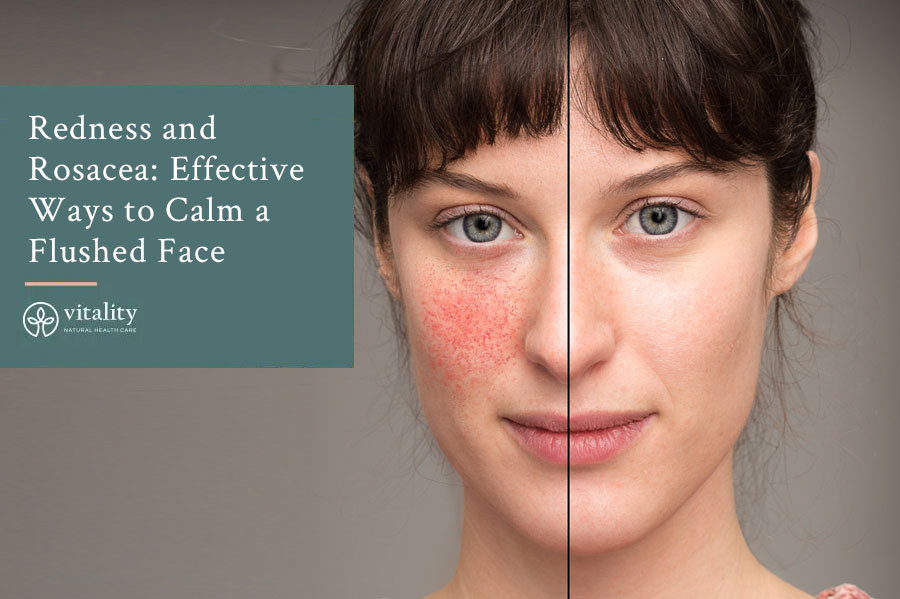Rosacea can make it difficult to feel comfortable showing your face to the world. While a flushed face may make you feel self-conscious, you are not alone. Rosacea is a very common skin condition, and there are many treatments available. If you are experiencing chronic hyperpigmentation, a dermatologist can help you find the root cause and work out a treatment plan that is right for you.
What is Rosacea?
Rosacea is a skin condition that is characterized by facial redness and visible blood vessels. In more severe cases, there may also be red bumps filled with pus. Usually the symptoms fluctuate, flaring up for weeks or months, and then going away again.
There is no specific test to diagnose rosacea, so it requires a discussion of your history and an examination of your face to receive a formal diagnosis. It is common for it to be mistaken for other skin conditions, such as eczema, psoriasis, or acne, so your doctor may need to conduct tests to rule out other possible causes for your skin redness or bumps.
What Causes Rosacea?
There is no one known cause for rosacea. However, light-skinned females over 30 are more prone to developing rosacea, especially if they smoke or have a family history of the condition. There are many factors that can exacerbate the symptoms and cause flare ups of a flushed face.
These include:
- Dietary factors, food sensitivities, and digestive imbalances. Common culprits include spicy foods, hot beverages, red wine, and other types of alcohol.
- Harsh skin care products or cosmetics which irritate the skin.
- Sun or wind exposure.
- Stress and intense emotions.
- Temperature extremes.
- Strenuous exercise.
- Chronic inflammation.
- Auto-immune diseases.
- Hormonal imbalances.
How to Calm a Flushed Face
While there is no “cure” for rosacea, there are many treatments that can significantly reduce symptoms. The most effective way to find out which treatment is right for you is to consult with a dermatologist, who can help determine the root cause. Since there are many lifestyle and environmental factors which can cause flare ups, it is best to go with a holistic approach for treatment. A flushed face may be a symptom of imbalances in the body, which need to be addressed in order to see improvement.
The first step is managing the triggers that cause flare-ups, and developing a good skin care routine. It may take some trial and error to determine if there are specific foods or products that exacerbate your symptoms. However, many people see improvement when they develop good habits to care for their skin, such as the following:
- Gently wash your face twice daily with a mild cleanser. To find a cleanser that doesn’t irritate your skin or cause redness, avoid products with soap, fragrances, alcohol, camphor, sodium laurel sulfate, glycolic acids, or other skin irritants. Avoid using exfoliants, washcloths, toners, and astringents. Circulate the cleanser gently using only your fingertips, and rinse thoroughly with lukewarm water. Residual cleanser left on the skin can cause further irritation.
- Moisturize daily, even if your skin feels oily. The increased water in your skin will sooth your face and reduce irritation. It also increases the effectiveness of rosacea-treating topical gels.
- Test makeup and skincare products on some other area of your body before applying it to your face. If you notice signs of irritation within 72 hours such as stinging or burning, do not use it on your face.
- Avoid sun exposure year-round. Seek shade and avoid the midday sun, or wear a wide-brimmed hat. Get into the habit of applying a broad-spectrum chemical-free (paraben and phthalate free) sunscreen with an SPF of 30 or higher every time you go outside, even if it is cloudy. Since some sunscreens can irritate sensitive skin, you may want to try one that contains only titanium dioxide or zinc oxide.
- Pay attention to which foods or beverages cause flare-ups, and try to avoid them. You may also consider trying an anti-inflammatory diet to see if that improves your symptoms.
- If stress is a trigger, develop habits that can lessen stress, such as a healthy diet, sufficient sleep, moderate exercise, and meditation/relaxation techniques.
- Gentle facial massage can help reduce inflammation and swelling.
- For many people, a good skincare routine and managing environmental factors is not enough, and they may need professional treatment as well to improve their hyperpigmentation. Many options are available, so it is best to talk to your dermatologist to determine which one will be the most effective for you. Some treatments that can improve symptoms include:
- Topical creams and gels. Some are used to reduce the redness by temporarily restricting the blood vessels, such as oxymetazoline or brimonidine. Other products are used to target the pimples, such as azelaic acid, metronidazole, and ivermectin.
- Oral medications. Some people may notice results with supplements that reduce inflammation or strengthen the immune system. Those with severe rosacea that don’t respond to other treatments may be prescribed antibiotics or acne medications.
- Laser therapy and light-based treatments have shown to be very effective for those who have constant issues with visible blood vessels or hyperpigmentation. Most people need a series of treatments, but many notice a complete clearing of their face which can last for years.
- Holistic treatments such as acupuncture, vitamin IV therapy, or chakra balancing target the root cause, and may help reduce or eliminate redness.
- Hydrafacials to moisturize and sooth your skin.
Don’t let a flushed face prevent you from living your life to the fullest. At Vitality Wellness Clinic, our skilled practitioners can help find the cause of your facial redness and develop an individualized treatment plan. Call our Chandler Med Spa at (602) 388-1155 to find out more about our rosacea treatment options to develop a balanced body and healthy skin.

